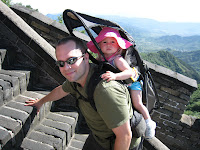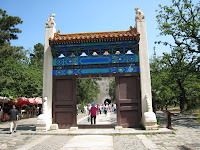We're Back from China!We left the land of the rising sun a little over a week ago to travel to Japan's roots in the much more ancient land of China. We decided to embark on this journey now since:
1. It's only a few hours from Japan.
2. We could not even imagine undertaking this adventure with 2 small children.
We had an amazing, enlightening, and completely exhausting experience traveling to 3 major cities in China within 6 days. We have been struggling with how to share our experience because of the sheer number of sights we visited and with how to incorporate some of the 600+ pictures we took. We decided to just dive right in and start one-by-one (through the sights, not the photos, don't worry!)
As an introduction we should tell you that in each city we had our own private tour guide and driver. Unlike in the US and many other countries, in China being a tour guide is a very competive and highly respected profession. All of our tour guides had been to university to study English and majored in tourism. They were all very professional and full of information. Without them China would have been a very difficult (to say the least) country to travel in. We especially liked our first 2 tour guides in Beijing and Xi'an. Our tour guide in Shanghai was much more business like and we did not connect with him in the same way (and he is the only one that didn't get our blog address...not that he would have been interested since he was always so busy doing other things like checking his stocks on his cell phone...but more on that later).
Beijing: Part I: Tiananmen Square and the Forbidden City
Our first stop was Tiananmen Square. As our tour guide (whose Chinese name was too difficult for us to remember and asked for us to call him Martin) pointed out, Tiananmen Square is the center of Beijing and the heart of China. It is the main plaza in Beijing and is directly in front of the Forbidden City where Emperors in China reigned for over 500 years. Tiananmen refers to the northern gate in the distance in the first picture which separates the square from the Forbidden City and literally means "gate of heavenly peace." The square encompasses a total area of 440,000 square meters, which makes it the largest open-urban square in the world. The square is also the site of several key events in Chinese history. Most people outside of China remember Tiananmen Square as the site of the 1989 uprising. The Tiananmen Square protests of 1989 were a series of demonstrations led by students and intellectuals between April 15th and June 5th, 1989. The protests started because of criticism of the Communist Party. The protests eventually resulted in a military crackdown that left many civilians dead or injured. The death toll ranges from 200 to several thousand people depending on the source.
Our time in Tianenmen Square was mostly spent running from place to place to talk with our tour guide as we tried to escape crowds of Chinese people wanting to touch, hug, and take pictures with Sydney. Who new that taking a cute blond-haired petite toddler to a country that only allows one child per couple (with some exceptions) could attract so much attention? After experiencing this throughout our travels in China we were both quite sure that we could never be celebrities and we had a new found understanding of celebrities contempt for the papparazzi. Our tour guides became instrumental in telling people that they could not take any more pictures and in retreiving our daughter from the crowds...somehow I doubt they learned how to do this at their Universities. We will soon post some of the pictures of Sydney and her fans in the gallery!

The Forbidden City is a complex consisting of 800 buildings with just under 10,000 "rooms" and covers 720,000 square metres. A "room" is the space between 4 pillars. Forbidden refers to the fact that no-one could enter or leave the palace without the emperor's permission. Construction began in 1406 and lasted for 14 years and used an estimated 200,000 workers. The Forbidden City was declared a World Heritage Site in 1987 and is the largest collection of preserved ancient wooden structures in the world. Of course, just like in Japan, almost all of these structures have been struck by lightning, burned down, and then rebuilt at least several times. They all now have wire outlines that serve as lightning rods.

You may recognize parts of the Forbidden city as it was used for the movie The Last Emperor.


One interesting thing that we discerned is that the Emperors were all paranoid, and apparently history proved several times that they were right to be so. The picture to the left is of the original brick floor in the Forbidden City. It is composed of 15 layers of bricks in criss-cross fashion and was designed so that no one could dig a tunnel under the Forbidden City and gain access to the Emperor. One other striking feature that the only trees or plants in the Forbidden City were in a small garden section at the far end of the complex. The emperors ordered that no trees would be in the main complex because they feared their enemies would hide in the trees. They also wanted nothing to exceed the height of the Hall of Supreme Harmony, where the Emporer gave his orders. The Chinese symbol for tree also is closely related to the symbol for trouble. We also learned that this general paranoia lasted well after the Emperor's deaths as even their tombs were designed for protection (but more on that later).

Can you guess what is contained within the Forbidden City building on the right? It is the only restaurant in the Forbidden City. Well, of course it's Starbucks! We were amazed that not only was there McDonald's, KFC, and Pizza Hut everywhere in China, but that these were all outnumbered by the amount of Starbucks there were! This Starbucks shop used to have a large sign, but this was removed and now the Starbucks in the Forbidden City is even more famous.
That's enough for one entry...stay tuned for a lot more about our trip!



















































